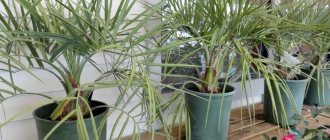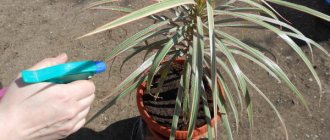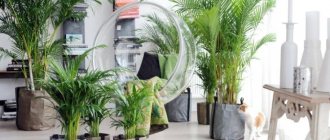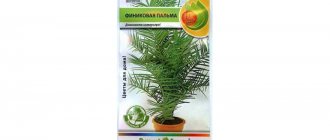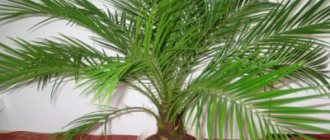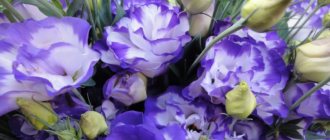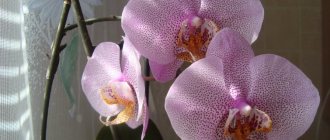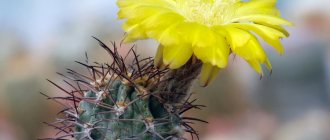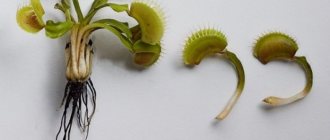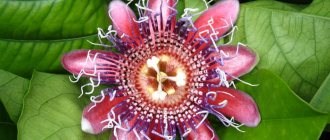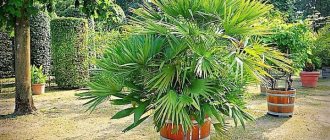The Washingtonia palm is a genus of woody plants in the Palmaceae family. Its homeland is the subtropical regions of Mexico and the United States of America. The palm tree is named after the first US President, George Washington. It has a high growth rate and tolerates mild short-term frosts well. Particularly large specimens grow up to thirty meters in height. The diameter of the feathery leaves reaches one and a half meters. The plant does not shed its old dried leaves for years, forming a kind of “skirt” on the trunk. This material will answer the question of how to care for Washingtonia.
Rules of care
- The lighting should be bright enough. A southern room, a veranda, a balcony - all this is suitable for a tropical miracle. While the plant is small, it needs constant supervision and care, and only when it becomes an adult can the tree grow in a place with less high light levels.
- You need to water the plant regularly, but take into account seasonality. In summer, when the weather is hot, the palm tree needs to be watered once a week. In winter, when it’s cold outside, watering should be reduced and done only when the soil is completely dry. During this period, the tree rests, but still should not be allowed to dry out. This will lead to the inevitable death of the palm tree.
- The air humidity in the room where the palm tree grows should be from 55 to 75 percent. To maintain such humidity, sprayers must be used. In winter, it is also practiced to wash the leaves with a damp cloth.
- As the tree grows, you need to rotate it in relation to the light source. This is necessary for the correct formation of foliage.
Sources
- https://sornyakov.net/komnatnye/vashingtoniya.html
- https://CvetnikInfo.ru/komnatnye-tsvety/palma-vashingtoniya.html
- https://fb.ru/article/259493/vashingtoniya-palma-vyiraschivanie-v-domashnih-usloviyah-foto
- https://flower-fan.ru/palma-vashingtoniya/
- https://dachadizain.ru/cvety/komnatnye/osobennosti-uxoda-za-palmoj-vashingtoniya.html
- https://www.glav-dacha.ru/ukhod-za-palmoy-vashingtoniey/
- https://tsvetydoma.ru/komnatnyie-rasteniya/palmyi/palma-vashingtoniya.html
- https://www.ocvetah.com/flowers/komnatnye/vashingtoniya.html
- https://chvetochki.ru/vashingtoniya/
Diseases
The main problems that arise when growing Washingtonia arise mainly due to violations of plant care requirements.
The plant doesn't grow
If watered too much, the apical bud of the palm tree may rot. And this poses a serious danger to the life of the entire plant. Excessive watering can even lead to rotting of the plant trunk.
The leaves have fallen
Washingtonia definitely needs high air humidity; if the air is too dry, the leaves begin to droop and fall off.
The leaves have turned yellow
If the palm leaves turn yellow, it means that proper watering is not provided or the plant does not have enough nutrition.
In the summer, it is necessary to protect the root system from drying out. If the edges of the foliage have darkened, it means there is insufficient air humidity in the room. The plant may need to be sprayed more thoroughly.
The tips of the leaves can also dry out due to insufficient watering or due to drafts and a decrease in the air temperature in the room.
Excessive lighting and direct sunlight can cause dry white spots to appear on the foliage.
When indoor temperatures drop, Washingtonia leaves may wilt and darken.
Are there dark spots on the leaves? Most often, this is also due to excessively frequent watering of the plant, and perhaps the temperature in the room has suddenly dropped. In addition, dark spots on the plant's foliage may appear due to parasites.
Parasitic pests
It is important to regularly monitor the plant for the appearance of parasites. Pests on a palm tree can appear due to violations of plant care rules.
The main enemies of Washingtonia are, as a rule, spider mites, scale insects, mealybugs, aphids and whiteflies.
An infected plant's foliage may curl and become mottled. To destroy these parasites, insecticides are mainly used. But sometimes folk methods of destroying them are also used. Spider mite. If this parasite appears on a palm tree, then you will find small light grains on the foliage, which will subsequently become covered with cobwebs.
The affected leaf becomes colorless, yellow spots appear on it, and it falls off.
To start fighting these parasites, you need to place the plant under running water (for example, a shower or watering hose) to rinse it, and then apply acaricides.
After this, it is advisable to treat with Fitoverm and Vertimek.
“Akarin”, “Agravertin”, “Neoron” can also help. Shield. If this parasite appears on a palm tree, you will find small dark yellow swellings on the foliage.
The foliage under the scale insect is often colorless. The use of insecticides to kill scale insects is ineffective.
Therefore, it is necessary to destroy scale insects with substances that attack the intestinal system of these parasites.
Mealybug. Has a "fluffy" appearance.
When there are many of them, these parasites resemble cotton balls.
The most effective means of killing mealybugs are substances that attack their intestinal system.
To destroy scale insects and mealybugs, the insecticide "Aktara" and auxiliary products are used - "Akarin", "Agravertin", "Karate" and many others like them.
Whitefly. If a whitefly has settled on a palm tree, then small white “flies” become noticeable on the attacked plant.
To destroy whiteflies, the insecticide "Aktara" and auxiliary products are used - "Akarin", "Agravertin", "Fitoverm" and some others.
Aphids are small parasites that are green, brown or black in color.
When there are a lot of insects, they group together.
The method of killing aphids is the use of insecticides: “Aktary”, “Akarina”, “Agravertina” or others.
After treatment, the parasites die after a short time (usually after 1–3 hours).
How to grow an evergreen giant from seeds?
Washingtonia from seeds is the only way to propagate this plant, since the palm tree does not produce side shoots.
For planting, select a container commensurate with the size of the tree. A small flower cannot be planted in a huge pot. When planting, you should follow several rules:
- 1Seeds should only be fresh, since the duration of their storage directly affects their germination.
- 2 Seed substrate, which consists of: leaf soil, peat, sand (2: 0.5: 0.5). Or moss, sawdust, sand in a ratio of 1:1:1.
- 3Before sowing seeds into the soil, you can use the growth stimulator Epin, in which you need to soak the seeds for 12 hours.
- 4Scarification - cutting the seeds with a very sharp knife (or rubbing with sandpaper). Place each seed in water for a period of 2 to 7 days.
- 5Place the seeds in the soil in a pot or tray, sprinkle on top to a thickness that is twice the diameter of the seeds.
- 6It should be warm enough from +25 to +30°C.
- 7Cover the pot or tray with film or glass to create a greenhouse effect.
- 8Ventilate and moisten regularly.
After 2-3 months, seedlings should emerge. When this happens, the tray with seedlings needs to be moved to a sufficiently lit place that is not exposed to direct sunlight. Plant seedlings of indoor Washingtonia when 2 leaves appear. Soil in pots for diving should be chosen for palm crops. It is best to start cultivating evergreen Washingtonia seeds in the spring. The seedlings grow very quickly, but the first fan leaves appear only after a year.
Botanical description and homeland of the plant
Washingtonia is a perennial tree plant of the Arecaceae (Palm) family, named after the first President of the United States.
This is a typical palm tree. The erect trunk reaches a height of 20-30 m, it is almost smooth, but there are scars left by the petioles of dead leaves. At the top of the tree, leaf plates are arranged like fans, cut into separate oblong segments, between which thread-like processes appear. Due to this feature, Washingtonia is also called the cotton palm. By the way, dry leaves remain on the trunk for a long time (gardeners get rid of them to maintain decorativeness) and are a refuge for birds and rodents.
In nature, the palm tree is distributed in the southern United States and western Mexico.
The plant's cold resistance (withstands short-term temperature drops down to -5 °C) allows the palm to be used to decorate parks, streets, and garden plots in regions with mild winters.
At home (this is what the article is devoted to), the Washingtonia palm tree is recently grown. It reveals its decorative effect in cool halls and winter gardens. Mostly young palm trees are grown in the room - up to the age of 7-8 years, in spacious rooms - up to about 15.
Diseases and pests
Despite the fact that the palm tree is a fairly hardened plant, it can still be susceptible to fungal diseases and attacks by various pests. As for the first point, here you will need to carry out proper watering. This is the only way to avoid diseases. Among the pests it is worth noting the following.
- Mealybug. It is a small insect that feeds exclusively on plant juices.
- Spider mite. Experienced gardeners consider it a very serious pest, despite its small size. It also feeds on the sap of the plant, while entangling the leaves with a web.
- Whitefly. This is a rather dangerous polyphagous insect that can be seen even with the naked eye. With its appearance, the leaves turn yellow and then completely fall off.
It is best to combat any of these insects with the help of special chemicals that can be purchased at any special institution. All doses are usually indicated on the packaging. But if they are not there, you can always ask the seller for help. Anyone who prefers to use only folk remedies in pest control can try wiping the leaves with a swab dipped in a solution of laundry soap. However, this approach will only help for preventive purposes.
For information on how to properly replant a palm tree, see below.
Washingtonia is powerful
Washingtonia robusta is native to the desert mountain valleys and canyons of Sonora and Baja Mexico. It is a popular landscape plant in Florida, California and Arizona, as well as other tropical areas.
Towering to heights of over 30m, these robust and architectural plants make a striking addition to any garden or indoor space, with their spiny leaves creating vibrant, dancing shadows in the summer sun.
The gray trunk (25.4-30.5 cm) is surrounded by closely spaced leaf scars, usually part of the trunk leaving dead leaves that, if not removed, simply hang down. Large, ribbed, fan-shaped leaves rise luxuriously above the sturdy trunk, forming an impressive canopy of bright green foliage. They have a rich, glossy green color and grow up to 1.5m long and 1.2m wide.
It is often called the cotton palm because of the tufts of cotton threads that hang from each leaf, ensuring a beautiful display in any setting.
When the leaves die, they envelop the trunk, a phenomenon called the “hula skirt.” Unfortunately, this fluffy skirt of dead, dry leaves provides a home for rodents and other unwanted creatures.
This type of palm is suitable as a centerpiece and will also look great in a large container in a patio or conservatory.
Preferences of Washingtonia powerful
These Washington palms prefer moderately rich, well-drained soil, but can survive even in sand.
Light Grows best in full sun but will tolerate some shade.
Watering Washington palm is drought tolerant once mature, but looks better and grows faster in moderate humidity.
Hardiness The species can withstand cold temperatures down to about -7 ° C, but at this temperature the foliage will be damaged.
The spread is propagated by seeds, which germinate within 2 months.
In general, W. robusta is more suited to wet climates, while W. filifera is a true desert species that is more tolerant of cold snaps if conditions are dry (however, persistent wet, cold conditions can cause death).
Growing indoor Washingtonia palm tree from seeds
To get an elegant fan-shaped beauty from a seed, you need:
- Fresh seed. You can buy it, or you can assemble it yourself.
- Mandatory scarification. An incision is made on the seeds with a very sharp knife and they are kept in water for two to seven days.
- Substrate for seeds. For it, take leaf soil, sand and peat in a ratio of 4:1:1.
It is optimal to begin the process of growing indoor Washingtonia in the spring. The prepared composition is poured into a tray, the seeds are laid out and sprinkled with the same substrate to a height twice the diameter of the seed. Then the container is covered with glass or polyethylene to create a greenhouse effect, and try to ensure a temperature regime of 25-30°C. Crops are regularly opened for watering and ventilation.
Within two to three months, the first seedlings should hatch. When this happens, the tray with seedlings is transferred to a well-lit place where there is no direct sunlight. After the second leaf appears, Washingtonia seedlings are planted in separate pots. The substrate is taken special for palm plants.
Note! Picking must be done very carefully so that the roots remain intact and the integrity of the endosperm is not compromised. You can grow a fan palm from seeds in other ways, which differ from the above in some nuances.
You can grow a fan palm from seeds in other ways, which differ from those described above in some nuances.
- When germinating seed, you can use peat tablets. One seed is placed on them and transferred to the ground. The top layer of the substrate is poured after the seedlings are noticeable.
- You can also germinate seeds in a different soil composition - you need to take sand, moss and sawdust in equal parts.
- First, before sowing the material both in the soil and in peat tablets, stimulate growth with the drug “Epin”. You need to soak the seeds in it for 10-12 hours.
Growing from seeds (step by step instructions)
If you decide to grow the Washingtonia palm tree yourself, you need to buy its seeds in a specialized store; the product must be certified. Sowing seeds should be done in spring or summer.
How to germinate at home? (procedure):
- Before sowing, the seeds must be prepared. To facilitate germination, the seed shell is slightly scratched with a sharp object (sandpaper, needle file, etc.) without affecting its core. Then the seeds are placed in warm water for 1–3 days to swell. The water is changed daily.
- The soaked seeds are sown in a container with a loose mixture consisting half of soil, peat and sand (in equal parts) and half of a nutrient substance (leaf soil or humus, which can also be purchased at the store). Plant the swollen seeds to a depth of about 1 cm.
- A kind of greenhouse is placed above the sowing; for this, the container is covered with some transparent material (film, glass, etc.) and placed in a warm place. For seed germination, a temperature of about 25–30 degrees is required.
- Every day this greenhouse is removed to ventilate the container. The mixture in the seed container must be constantly moist, for which its surface must be regularly sprayed (for example, from a spray bottle).
- The time at which sprouts appear depends on the freshness and quality of the seeds. Fresher and better quality ones sprout within 15–20 days. Older and lower quality ones can take two to three months to germinate.
- After seed germination, the finished sprouts are planted in separate containers. A prerequisite is that the sprouts must have two true leaves, which will indicate that the seedlings have become stronger.
Description
Washingtonia lives in the subtropical zone, with a suitable Mediterranean climate. Therefore, it is found naturally in the southwestern United States and northwestern Mexico. Botanists know two varieties of Washingtonia
These species can grow in North Africa and southern European countries. When kept at home, it requires special attention. But caring for the palm tree will return beautiful fan-shaped leaves that will decorate any room. The palm tree can grow up to thirty meters in height
Its trunk reaches one and a half meters in girth. The leaves are very large, fan-shaped, and can grow up to 150 cm in length. The green leaf is cut to the center of the leaf. The trunk may be in knots if there are remains of leaves. Or it can be smooth if all the foliage along with the bare petioles has fallen off. Palm flowers are formed in a spikelet and are located on a long flowering stem. The flowers on the plant are bisexual and, after pollination, form dark brown fruits. The palm seeds are edible; the Indians living there eat them. In addition to people, birds eat the seeds. At home, Washingtonia practically does not bloom. Usually it can form a flower-bearing arrow once in 4-6 years.
Types and varieties of Washingtonia
Two types of indoor Washingtonia are cultivated:
California filamentous Washingtonia
In nature it forms a palm forest. The leaves have a gray-green color with a yellow rim along the edges and white thin threads. The palm tree grows up to 20 meters and in diameter up to six meters. Dying leaves do not fall off, but form a skirt of leaf debris.
Small birds or invertebrate fauna like to live in such nests. When kept indoors in winter, the palm tree needs a temperature no higher than 15 degrees and natural light.
Mexican robusta palm
It can grow into a thirty-meter beauty with huge fan-shaped leaves of bright green color. All leaves are at the very top. Each meter-long petiole is protected by small thorns. The inflorescence reaches three meters in length and bears many orange and pink flowers. The resulting fruits are blue-black drupes. In indoor conditions, there is no need to lower the temperature in winter.
Popular varieties and types of exotic palm trees
Usually in our apartments you can find the two most popular types of indoor palm trees.
Washingtonia filamentosa (filamentous)
Its homeland is California, so the plant has another name - California fan palm. In places where it grows naturally, it creates entire forests. The leaves of this tree have a gray-green tint and many fine white threads. For a comfortable wintering of thread-bearing Washingtonia, it is necessary to provide an air temperature of 6-15 ° C plus a well-lit place.
Washingtonia robusta (potent)
The tree was born on the shores of Mexico, so it is not surprising that it is also called the Mexican palm. Mature plants have a taller trunk than Californian relatives and can reach thirty meters in height. The foliage of Washingtonia is powerful, rich green, but without snow-white threads. The leaf petioles have thorns, and the crown itself is located at the top of the trunk and looks very compact. Wintering of this species does not require special conditions and can be carried out in the indoor mode familiar to the owners.
Home care for palm trees
Lighting and location
The best location for Washingtonia is windows on the east or west side. The palm tree requires good lighting, but the rays should not be direct, but should be evenly dispersed. In the hot summer season, it is better to move the palm tree to a darker place.
Temperature
In spring and summer, the palm tree is most comfortable at a temperature of 20-24°C.
If the temperature is still above thirty degrees, then Washingtonia must be moved to a cool place. This plant can exist at sub-zero temperatures, so in winter it needs 7-10°C.
Watering
Washingtonia needs to be watered with lukewarm water. In summer, the palm tree needs to be watered as soon as the top layer of soil is dry. But do not overdo it, the plant does not tolerate high moisture, as well as dry soil. In winter, the palm tree needs to be watered 2-3 days after the top of the soil has dried.
Air humidity
For indoor Washingtonia, air humidity is very significant. The plant loves it when it is sprayed and the leaves are wiped with a soft damp cloth.
Feeding and fertilizers
The rest of the time, Washington does not require this. It is possible to fertilize the soil with different group compositions, which include a huge amount of iron. They must be administered twice a month.
Trimming
Washingtonia pruning is done in order to stop the leaves from drying out. However, this process is not considered integral in any way, since dried and drooping leaves do not in any way worsen the appearance of the palm tree. If you decide to prune, this must be done before the entire leaf turns yellow.
Transfer
Before replanting the plant, you should organize the foundation. It should be combined with turf, deciduous leaves, sand and humus in a ratio of 2:2:2:1. Transshipment is carried out with special frequency. If the palm tree is younger than 7 years old, it must be replanted once every 2 years, if it is older than 7 years - every 3 years, if Washingtonia is older than 15 years old, it must be replanted once every 5 years. When transshipping, the base of older palm trees is fed with up to 5 kilograms of organic matter, and if, as the palm tree grows, the roots begin to protrude from the pot, they need to be covered with earth.
Growing
The palm tree is grown in homes and offices as an ornamental plant . It requires special conditions of detention.
- The temperature in spring and summer is 20-25℃, in autumn and winter - 10-12℃.
- Illumination: bright diffused light, daylight hours at least 16 hours.
- Location: windows facing east or west.
- Watering is moderate after the top layer of soil has dried, less often in winter.
- Air humidity should be increased; in summer, the palm tree is sprayed, wiped with a damp sponge, and humidifiers are used; in winter, there is no need to moisten it additionally.
- Feeding: during the growing season from spring to autumn, 2 times a month.
- The dormant period is from late autumn to early spring.
- Replant the plant only if necessary. Young palms up to 7 years old - every two years, then the older, the less often.
- The composition of the soil is humus (you can use peat instead), turf soil, leaf soil, sawdust.
- Washingtonia propagates by seeds.
- Diseases: rotting of roots, yellowing and drying of leaves, appearance of spots on them.
- Pests: whiteflies, scale insects, spider mites.
Washingtonia filamentous or filamentous (Washingtonia filifera)
There are only two species in the genus, which are not very different from each other. Both representatives can be grown indoors if you know what their most important difference is - the temperature regime. First of all, let's talk about a more cold-resistant species, Washingtonia filamentosa; it is a perennial palm tree up to 25 meters high. The trunk has a cylindrical shape. Its diameter is up to 80 cm. The gray surface is covered with interspersed leaf petioles, which is why it can have a ribbed structure.
Towards the top, the trunk of filamentous Washingtonia gradually narrows and bears a rosette of fan-shaped leaf plates. The leaves of the plant reach 3-4 meters. The leaf blade is pinnately dissected into 70-90 pieces. The middle part is represented by xiphoid segments, up to 1.5 meters long and up to 6 cm wide. The extreme part is smaller in length (up to 80 cm) and width (up to 1 cm). The entire leaf blade has white threads that hang along the edges of the fan leaves.
The leaves of Washingtonia filifera are attached to the trunk by large woody petioles. On their lower surface there are sharp, spine-like teeth of a yellowish color with a bent tip towards the shoot of the palm tree. During the period of active growth, which lasts from early May to autumn, up to 13 leaves are formed, which have a lifespan of 2-4 years.
The flowers of filamentous Washingtonia are collected in long paniculate inflorescences, reaching from 3 to 5-6 meters in length. They are bent in an arc towards the surface of the trunk. After flowering, fruits are formed - oblong drupes with a fleshy surface and seeds.
Biological description
Washingtonia is a single-stemmed plant with a spreading fan-shaped crown. The upper part of the gray trunk is entwined with dried leaves and brown felt. The length of the leaf plate is 50 cm. Each palm leaf consists of elongated segments split from the base. The green leaves are hard to the touch. The length of paniculate inflorescences can reach three meters. The palm fruit is a small, dark-colored drupe.
Planting a Washingtonia Palm
The plant is cultivated as an ornamental foliage plant.
The crop requires very good illumination, the light must have such a characteristic as diffuseness, this is absolutely necessary. Daylight should last for approximately 16 hours. During the winter season, Washingtonia needs to be illuminated with additional light sources.
In spring and summer, the plant requires temperature conditions within 20-24 degrees, no more, in the winter season - about 10 degrees.
In spring and summer, the soil mixture in the container is moistened after the surface soil layer has dried. In cold weather, watering is applied in a small volume and rarely, but it is unacceptable that the soil ball dries out.
Air humidity should be high. During the growing season, Washingtonia leaves are moistened 2 times/24 hours, in addition, the leaves are washed once a week with a wet sponge. In order to increase the level of air humidity, open containers filled with water are placed near the tree. During the winter season, wetting the palm tree is prohibited.
It is necessary to apply fertilizers from spring to autumn 1 time/15 days; fertilizing should contain a large amount of iron. In winter, fertilizers are not applied.
The dormant period begins late in the fall, and ends at the beginning of the spring season.
In the spring, the Washingtonia palm tree is replanted if really necessary. Up to 7 years, the plant is replanted once every couple of years, up to 15 years - 1 time/three years, adult Washingtonia is replanted once/4-5 years.
The soil mixture contains peat (or humus), sand, leaf and turf soil for the Washingtonia palm tree, in a proportional ratio of 2:1:2:4, respectively.
The houseplant Washingtonia is cultivated by seed.
Pests that can threaten with their attacks: scale insects, whiteflies, spider mites, mealybugs.
Diseases. Rot can affect the root system of the Washingtonia palm tree due to improper watering rules or a lack of drainage layer in the container. Drying of the tips of Washingtonia leaves may occur due to the dry air at home.
Diseases, pests and growing problems
This may occur due to poor watering or lack of fertilizers.
I really want to prevent such a beautiful and large Washingtonia palm from disappearing. To do this, you only need to take a couple of nuances, which is why Washingtonia indoors may feel bad:
- when the tips of the leaves darken, this is a sign that indoor Washingtonia is either poorly watered or lacks potassium fertilizers. How to prevent the Washingtonia palm from disappearing in this case is clear and understandable.
- If, despite the fact that watering is carried out regularly and according to the rules, and the leaves still darken, then indoor Washingtonia will pick up moisture. Therefore, it urgently needs to be marked on the container in which water is poured, and sprayed more often.
- If a Washingtonia palm disappears because the leaves have become spotted, then this is a sign of a sharp change in temperature or excess moisture. The newly created normal conditions for the indoor palm will correct this problem.
- Withering and drying out of the foliage of the Washingtonia palm tree can sometimes indicate not at all that it is disappearing. This is part of the natural process of growth and development, but only if signs of decay have not been identified.
- An indoor palm tree affected by insects will not look healthy: small spots that have lost pigmentation will be visible on the leaves, and the leaves will begin to curl. This damage is caused by scale insects, scale insects and whiteflies. To rid an indoor palm tree of them, you should apply the insecticide in the required concentration according to the instructions.
Important: when the foliage naturally dries out, dead leaves should be removed. But it is important not to confuse the natural process of leaf renewal with a disease that is caused by an excess of water in the tub.
Types of indoor palm trees
Palm trees have been used to decorate interiors in our country for a long time, since the beginning of the 19th century. Of the entire variety of natural species, about 20 are common in indoor floriculture. Depending on the size and shape of the leaves, several groups are distinguished.
Reed
Reed palm
This group of plants has thin stems reminiscent of bamboo shoots with a height of 1 m or more. They are suitable for spacious rooms.
Chamaedorea Seifrizii and Chamaedorea Erumpens have dark green leaves, only the former has narrow leaves, and the latter has wide leaves. Their height can reach 2–3 m.
Cirrus
Palma pinnata
The fronds of plants in this group are divided into leaves, which can be soft and arched or hard and straight.
Fan
fan palm
The large leaves are shaped like segments, fanning out from the base of the leaf blade. The petioles are long, with spines.
Canary date (Phoenix canariensis)
Date canarian
Popular view. It is often offered in garden stores and centers. Growing up, it turns into a large plant with narrow, hard and straight leaves. Unpretentious, he only needs sunlight from the window.
Date Robelena
Does not grow above 2 meters. The lush crown with curved narrow leaves looks very beautiful.
Chamaedorea elegans (Chamaedorea elegans)
Hamedorea gracilis
One of the most common compact types. It is loved by flower growers because it is perfectly adapted to pot growing in small spaces, although in its native Mexico it grows in humid forests. It grows very slowly, reaching only 60 cm in a few years. In good light, yellow flowers appear in adult specimens and fruits are set.
Howea
Hovea
Varieties of this palm tree are shade-tolerant and resistant to pests. Does not lose its decorative effect in dry indoor air. A suitable plant for novice gardeners who want to grow an exotic southern plant for the first time.
Livistona Chinese
Slow growing palm. It is distinguished by large leaves with drooping tips.
Washingtonia filifera
Washingtonia filamentosa
Originally from North America. It can be immediately recognized by the fibers on the edges of the leaves, which in appearance resemble a beard.
Rapis
Rapis tall
An unpretentious Asian palm, drought-resistant. Several species are grown at home: tall rapeseed (Rhapis excelsa), multi-cut rapeseed (Rhapis multifida), as well as popular varieties of tall rapeseed with variegated foliage.
Fishtail Palms (Caryota)
Kariota
Forms graceful low bunches of stems. Green leaves of unusual shape, up to 15 cm long and up to 10 cm wide. They look impressive and are easy to care for.
Types of Washingtonia with photos
Washingtonia filifera
This species is native to the eastern United States of America. In nature, the height of a palm tree can reach about 20 meters. The trunk is straight and even, and at its top grow grayish-green fan-shaped leaf plates. The cut leaf plates reach about 200 cm in length by a third, and about 80 lobes are formed on each of them. Long white threads grow at the edges of the foliage. The color of the flowers is white.
Pandanus care at home
It is not at all difficult to care for the plant. This unpretentious indoor palm tree does not make any special demands on its existence. For successful maintenance, it is advisable to consider some of the subtleties of its care.
Selecting a location and temperature
The Pandan plant thrives throughout the year in bright light. It is better to place indoor pandanus near windows from the west or east. It is advisable to rotate the pot with the plant periodically to prevent it from being one-sided.
Important! Lack of lighting will negatively affect the brightness of foliage color. Temperature ranges from 19˚С to 25˚С will be acceptable for indoor palm trees all year round.
Temperature ranges from 19˚С to 25˚С will be acceptable for indoor palm trees all year round.
Remember! During the cold period, the temperature in the room should not be lower than 13˚C. This temperature limit leads to the death of pandan.
Pandanus has a love of fresh air. So periodic airing will be pleasant for the flower.
Main! Protect your indoor plant from drafts.
Humidity and watering
The pandanus palm can be content with moderate environmental humidity levels. You can wipe the leaves from bottom to top with a damp cloth. Be sure to use gloves. There is no need to get rid of the aerial roots that have appeared; add some moss to the flowerpot and keep it moist. For greater comfort, you can use flower pots with automatic watering.
Summer watering should be plentiful at intervals of 3 days. It is necessary that the upper part of the earthen mixture dry out slightly between waterings. We use slightly lukewarm and settled water. In the cold off-season, we reduce watering and be sure to monitor the condition of the substrate.
Soil mixture and its fertilizer
Turf and leaf soil, sand and humus are a suitable and comfortable soil mixture (equal parts).
This flower needs systematic feeding in the off-season. It is better to use a complex mineral fertilizer, which is suitable for all decorative foliage plants.
How to propagate pandanus?
Using seeds, separated bushes and cuttings.
Seeds are sown in a sand-peat mixture and stored in a mini-greenhouse at a temperature of +25 °C. It is advisable to look occasionally and moisten the earthen mixture. In a month the shoots will appear. It is better to plant seedlings with three leaves in a stable place.
The cut lateral twenty-centimeter cuttings are slightly dried, having previously treated the cuts with charcoal. They are rooted in a soil mixture of equal parts sand and peat. We organize greenhouse conditions with temperatures of 25-28˚C. We systematically ventilate and water with a spray bottle; within one and a half to two months the sprouts acquire roots.
Daughter rosettes formed on the trunk or leaf axils are also suitable for propagation of the screw palm. We separate the rosettes with small roots and plant them in flat flowerpots. Good drainage of at least twenty millimeters is required, then turf soil of at least seventy millimeters and sand, a layer of at least forty millimeters. We plant the roots in the sand, press them, cover them with translucent hermetic material and create a comfortable temperature of more than 22 degrees. After 2 months, the matured cubs are transplanted into larger pots.
Transfer
The screw tree has rather fragile roots. Therefore, replanting must be done very carefully, transferring from a small pot to a larger one. Every year you can renew the flowerpot for young specimens, and for older palm trees you can increase the period to three years by filling the flowerpot with roots.
Pandanus pests and diseases
Occasionally, the plant is attacked by uninvited guests: scale insects, spider mites, and scale insects. If pests are identified, treat the plant with an insecticide. However, in general, the indoor pandanus palm is not very attractive to pests.
Difficult moments of growing
- Pandanus leaves turn yellow - the earthen mixture is oversaturated with calcium; hard water is used for irrigation; lighting is too bright.
- The foliage is too small and the variegated saturation of its color fades - the palm tree does not have enough light.
- The ends of the leaves dry out and turn brown - low air humidity.
Carefully read the interesting aspects of growing indoor pandanus, love it, take care of it, and this miracle palm tree will decorate both your home and office space.
You can get acquainted with other interesting indoor flowers by opening the catalog of indoor plants on the website.
Reproduction
The Washingtonia palm reproduces by seeds. Seed germination lasts up to five years, but the fresher the seeds, the sooner they germinate. Seeds are planted in the ground in the spring. The soil for this should be loose and consist of 4 parts of garden soil and 1 part of peat and sand.
Seeds can also be germinated in clean sand, sawdust, and peat. The main condition is a loose substrate, this is necessary for unhindered access of air and water.
To quickly germinate seeds, they can be soaked for 10-12 hours in the Epin solution. It’s good if you plant the seeds in peat tablets.
The seeds are buried in the substrate to a depth of 1-1.5 cm, and the container or pot is covered with film. Seeds germinate at a substrate temperature of 25-30C. Washingtonia sprouts from seeds in approximately 20 days.
Strong seedlings are transplanted into pots with a diameter of 7-8 cm. The seedlings grow quite quickly. Young plants are fed with complex mineral fertilizer during growth.
Washingtonia does not reproduce vegetatively; the only way is to sow seeds. With this method, the palm tree grows for a long time, and if you want to quickly have a ready-made plant, you can buy it at a flower shop.
Varieties of Palms
Washingtonia has several varieties that differ not only in external features, but also in the nuances of growing at home. The most common types of plants are:
- Washingtonia filamentosa (filamentous). In nature, it has become widespread in the south of North America. Medium specimens grow up to 20–22 m in height and up to 6 m in diameter. The foliage of the thread palm is light green with white veins. Its fruits are edible. This palm tree prefers cool temperatures of 5–15 °C in winter, so it is rarely grown at home.
- Washingtonia Robusta (Santa Barbara). A taller species with edible seeds. It is used more often as a houseplant because it has weaker frost resistance.
Washingtonia powerful (aka Robusta) is a frequent guest among indoor plants. This option is ideal for landscaping offices or shopping centers, as well as residential buildings. If you provide proper care to such a plant, it can grow in just a few years.
Robusta is an ideal option for landscaping offices, shopping centers and residential buildings
Total information
The plant got its name from the first US President George Washington, but it is mainly used only by specialists - botanists. For the rest of the world's population, this is an ordinary palm tree growing in warm countries. The genus Washingtonia includes only two species: Washingtonia powerful and Washingtonia filamentous, which differ from each other by different shades of leaf petioles. In Washingtonia powerful they are brown, and in filiform they are gray-green.
Washingtonia filamentosa.
Washingtonia filamentous is a tree that in natural conditions grows up to 15-20 meters. The trunk is round, cylindrical, with a diameter of up to 1 meter at the bottom, gradually tapering upward. The petioles of fallen leaves remain on the trunk, forming strong, hard scales. The indoor Washingtonia palm tree does not grow more than 2-3 meters in height.
The leaves of the palm are fan-shaped, up to 4 meters long, green or gray-green in color, the leaf blade is dissected by 1/3, into 80-90 segments. In the middle, the segments are long - up to one and a half meters, at the edges - up to 60-80 cm. On the edges of the leaves there are thin, twisted white threads, which is why the palm is called filamentous or filamentous.
Leaf cuttings are the same length as the leaf blades; in the lower part they have sharp spines curved towards the trunk. During the season, the palm tree grows 12-13 leaves, which live for 3-4 years and then fall off.
The filamentous palm blooms in paniculate inflorescences up to 5 cm long, with white, bisexual flowers. After the flowers, a fruit is formed in the form of an oblong drupe 1 cm long. The drupe is black or dark brown, shiny, the seeds inside are small, oval.
Appearance
When Washingtonia palm species grow in their natural environment, they are fairly tall plants with large leaves.
The plant has branched inflorescences-cobs and leaves, the diameter of which reaches 1.5 m. The trunk of the palm tree is rough, gray in color, the height does not exceed 30 m. Old leaves may not fall off for a long time, as a result of which the trunk is covered with a dense “skirt”. The plant is one of the so-called fan palms, as its leaves take on the shape of a fan. The resulting fruits are spherical in shape, they are quite fleshy, the seeds are lignified. Birds often like to peck them.
Watering Washingtonia
Washingtonias like a lot of water. It is a good idea to create some kind of water space around the root by separating the edge of the soil about 40cm from the trunk. Creating drainage at the bottom of the container will help remove excess moisture. Keep the soil moist but not soggy and limit the amount of water in winter because it is a desert plant. In summer, on hot days, spraying is advisable to increase air humidity.
Feeding. Fertilize your Washingtonia every month with a water-soluble or granular plant fertilizer, intermittently in early spring. Choose a balanced plant fertilizer that contains equal amounts of nitrogen, phosphorus and potassium.
